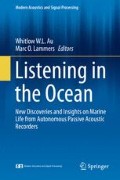Abstract
The Perennial Acoustic Observatory in the Antarctic Ocean (PALAOA) was developed to study the underwater vocal behavior of cetaceans and pinnipeds and to monitor ambient noise levels in the Southern Ocean. Establishing an autonomous long-term observatory in Antarctica is challenging mainly because of the harsh weather conditions and logistic constraints. The project goal was to build an autonomously operating, passive-acoustic observatory which allows scientists (1) to reliably and continuously record the Antarctic underwater soundscape year-round, (2) to record all vocalizations produced by marine mammals in the study area (frequency range of the recordings: 10 Hz to 96 kHz), (3) to locate vocalizing marine mammals and other underwater sound sources, (4) to obtain information on ambient noise levels in the area, and (5) to access and analyze the incoming acoustic data stream in real time at the Alfred Wegener Institute for Polar and Marine Research (AWI) located in Bremerhaven, Germany.
Access this chapter
Tax calculation will be finalised at checkout
Purchases are for personal use only
Notes
- 1.
Definition: The Southern Ocean, also known as the Antarctic Ocean or the South Polar Ocean, is, by definition of the International Hydrographic Organization, the oceanic division encircling Antarctica. It comprises the southern-most waters of the world’s oceans south of 60° S latitude.
- 2.
PALAOA = Hawaiian; means (sperm) whale, whale tooth
- 3.
- 4.
- 5.
- 6.
- 7.
References
O. Boebel, H. Klinck, L. Kindermann, S. El Naggar, PALAOA: broadband recordings of the Antarctic coastal soundscape. Bioacoustics 17, 19–21 (2008)
S.Z. El-Sayed, Biological aspects of the pack ice ecosystem, in Symposium of Antarctic Ice and Water Masses, ed. by G. Deacon (Heller, Cambridge, 1971), pp. 35–54
E. Fahrbach, G. Rohardt, Die Zirkulation im Weddellmeer– ein Fenster zur Tiefsee, in Polarstern– 25 Jahre Forschung in Arktis und Antarktis, ed. by D.K. Fütterer, E. Fahrbach (Delius Klasing Verlag, Bielefeld, 2008), pp. 137–147.
T.A. Jefferson, S. Leatherwood, M.A. Webber, FAO species identification guide. Marine mammals of the world (FAO, Rome, 1993). 320 pp.
M. Kaiser, M. Attrill, S. Jennings, D.N. Thomas, D. Barnes, A. Brierley, N. Polunin, D. Raffaelli, P.B. Le Williams, Marine Ecology – Processes, Systems, and Impacts (Oxford University Press, New York, NY, 2005), p. 584
H. Klinck, Automated passive acoustic detection, localization and identification of leopard seals: from hydro-acoustic technology to leopard seal ecology. Rep Polar Mar Res 582, 154 (2008)
H. Klinck, D.K. Mellinger, K. Klinck, J. Hager, L. Kindermann, O. Boebel, Long-range underwater vocalizations of the crabeater seal (Lobodon carcinophaga). J. Acoust. Soc. Am. 128, 474–479 (2010)
L.F. Lowry, J.W. Testa, W. Calvert, Notes on winter feeding of crabeater and leopard seals near the Antarctic Peninsula. Polar Biol. 8, 475–478 (1988)
D.K. Mellinger, K.M. Stafford, S.E. Moore, R.P. Dziak, H. Matsumoto, An overview of fixed passive acoustic observation methods for cetaceans. Oceanography 20, 36–45 (2007)
U. Nixdorf, H. Oerter, H. Miller, First access to the ocean beneath Ekströmisen, Antarctica, by means of hot water drilling. Ann. Glaciol. 20, 110–114 (1994)
W.J. Richardson, C.R. Green Jr., C.I. Malme, D.H. Thomson, Marine Mammals and Noise (Academic Press, London & San Diego, 1995). 576 p
A.M. Seibert, The Ross Seal and Its Underwater Vocalizations (Ludwig Maximilian University of Munich, Germany, Munich, 2007). M.Sc. thesis
D.B. Siniff, An overview of the ecology of Antarctic seals. Am. Zool. 31, 143–149 (1991)
A. Sirovic, J.A. Hildebrand, S.M. Wiggins, Blue and fin whale call source levels and propagation range in the Southern Ocean. J. Acoust. Soc. Am. 122, 1208–1215 (2007)
V. Smetacek, S. Nicol, Polar ocean ecosystems in a changing world. Nature 437, 362–368 (2005)
D. Steinhage, U. Nixdorf, U. Meyer, H. Miller, New maps of the ice thickness and subglacial topography in Dronning Maud Land, Antarctica, determined by means of airborne radio-echo sounding. Ann. Glaciol. 29, 267–272 (1999).
P.L. Tyack, Acoustic communication under the sea, in Animal Acoustic Communication, ed. by S.L. Hopp, M.J. Owren, C.S. Evans (Springer, Berlin, 1998), pp. 163–220
I. Van Opzeeland, L. Kindermann, H. Klinck, J. Ploetz, H. Bornemann, S. Van Parijs, O. Boebel, Mar. Ecol. Prog. Ser. 414, 267–291 (2010)
I. Van Opzeeland, S. Van Parijs, L. Kindermann, E. Burkhardt, O. Boebel, Calling in the cold: pervasive acoustic presence of humpback whales (Megaptera novaeangliae) in Antarctic coastal waters. PLoS One 8, e73007 (2013)
Acknowledgements
The authors thank Sharon Nieukirk and Sara Heimlich for their helpful comments on the book chapter. Field work and maintenance of PALAOA would not be possible without the help of the AWI logistics department and the Neumayer Station overwintering teams. The PALAOA project is partly funded by the Bremerhavener Gesellschaft für Innovationsförderung und Stadtentwicklung (BIS), the European Union (EU), and the Alfred Wegener Institute for Polar and Marine Research.
Author information
Authors and Affiliations
Corresponding author
Editor information
Editors and Affiliations
Rights and permissions
Copyright information
© 2016 Springer Science+Business Media New York
About this chapter
Cite this chapter
Klinck, H., Kindermann, L., Boebel, O. (2016). PALAOA: The Perennial Acoustic Observatory in the Antarctic Ocean—Real-Time Eavesdropping on the Antarctic Underwater Soundscape. In: Au, W., Lammers, M. (eds) Listening in the Ocean. Modern Acoustics and Signal Processing. Springer, New York, NY. https://doi.org/10.1007/978-1-4939-3176-7_8
Download citation
DOI: https://doi.org/10.1007/978-1-4939-3176-7_8
Published:
Publisher Name: Springer, New York, NY
Print ISBN: 978-1-4939-3175-0
Online ISBN: 978-1-4939-3176-7
eBook Packages: Earth and Environmental ScienceEarth and Environmental Science (R0)

